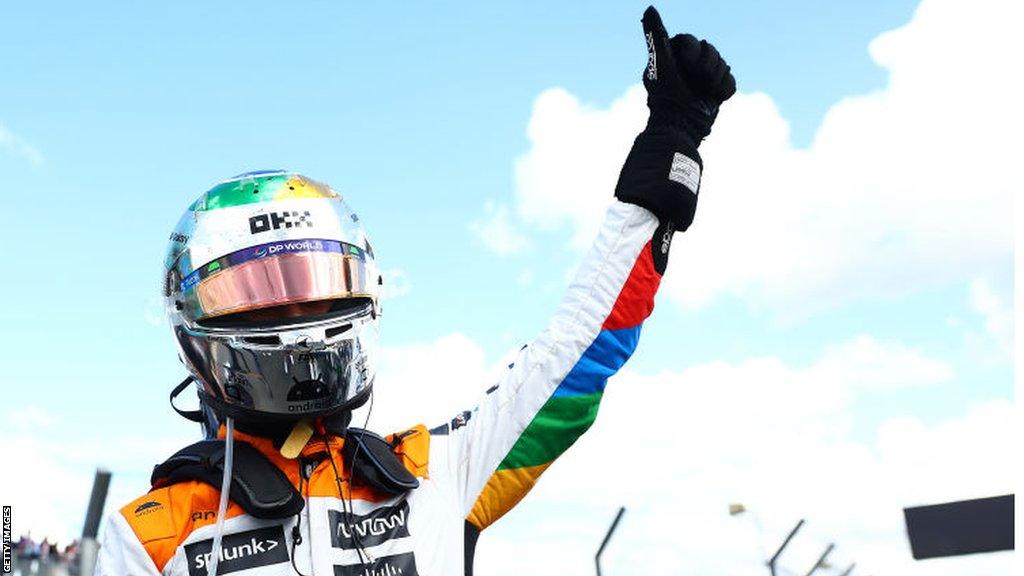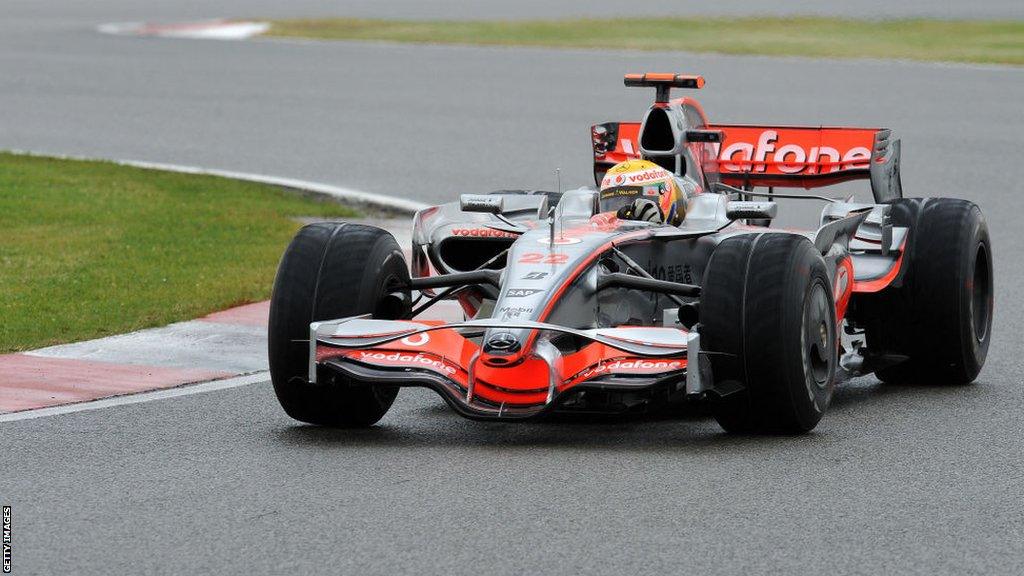British Grand Prix 2023: 'Lando Norris shows McLaren progress but work still to do'
- Published

Lando Norris briefly took the lead at Silverstone on Sunday
Lando Norris first fell in love with Formula 1 watching Lewis Hamilton and Fernando Alonso battling at the front in silver McLarens at Silverstone back in 2007.
On Sunday, he found himself in the same position on that same track, and he said he felt "very proud".
Like Hamilton had so many times before him, now - for the first time - Norris stood on the podium at his home grand prix, soaking up the cheers and chants of the crowd.
"It's pretty special to be in that position," he said.
A record 160,000 spectators were cheering Norris from the very first seconds of the race, as he catapulted away from his second place on the grid past Max Verstappen's Red Bull and into the lead.
"My heart was racing a bit more than normal," he said, "and I was watching the crowd."
The moment he led his home race was never going to last. Norris knew that, and so did everyone watching. Verstappen and his car are just too strong this year, and the Dutchman was always going to get past and win the race, barring some kind of problem.
But once Verstappen was gone, Norris stayed in second all race, holding off a charge from Hamilton in the closing laps.
Afterwards, the beauty of the moment and the road he had travelled was not lost on him.
"I was seven," Norris said, recalling those times years ago. "It is what made me want to be a racing driver. Little did I know Lewis would still be here 15 years later and still going strong. It's an honour to be able to race with these drivers who have created history and be some of the best drivers ever to come through F1.
"I want to be someone who can join in and create some of my own history. It's an honour and a privilege and exciting at the same time."

Lewis Hamilton won the 2008 British Grand Prix in the iconic chrome-liveried McLaren
A spectacular transformation
McLaren's performance at Silverstone suggested Norris' ambition is a lot closer than it appeared just a couple of weeks ago.
An upgrade introduced on to the McLaren in Austria last weekend transformed the car.
From being the sixth quickest in the field on average over the first eight races of the season, and close to the slowest of all at a dire opening race of the year in Bahrain - home race of the team's owners - Norris qualified and finished fourth at the Red Bull Ring. A week later, the McLaren was the genuine second fastest car on the grid at Silverstone.
Norris and his impressive rookie team-mate Oscar Piastri qualified second and third to Verstappen, and they would almost certainly have finished in those positions, too, had a safety car period in the second half of the race not allowed Hamilton a cheap pit stop and vaulted him ahead of the Australian.
Afterwards, Piastri acknowledged the moment was "bittersweet". "Fourth is a great result," he said, "but when it could have been third if not for a safety car, it stings a little bit."
Piastri's moment will come. His debut season was already quietly impressive, given the difficulties McLaren were facing with their car, and the team's progress both softens the disappointment he felt and strongly suggests he will have other opportunities to shine.
McLaren's performance at Silverstone was their strongest since the Italian and Russian Grands Prix back in 2021.
Piastri's predecessor at the team, Daniel Ricciardo, and Norris finished one-two in Monza two years ago, after Hamilton and Verstappen had crashed out together, and Norris was on course for his first victory in Sochi before a late-race rain shower dashed his hopes when the team failed to pit early enough for wet tyres.
Those results ended up being a flash in the pan. McLaren have faced a difficult time since. They fell back with the advent of F1's new regulations in 2022, and before this season admitted they had missed their development targets with their new car.
They had seen a design direction that would deliver performance too late, they said, and it would take time to bring it to reality. That time was Austria, and the impact has been nothing short of spectacular.
A different model
Before the transformation on track, there was one off it. Italian Andrea Stella was installed as team principal in December, as part of a merry-go-round of moves that saw his predecessor Andreas Seidl move to Alfa Romeo/Sauber to begin its transformation into Audi's factory team in 2026, replacing Frederic Vasseur, who went to Ferrari to replace the sacked Mattia Binotto.
Stella - an engineer who joined McLaren back in 2015 along with Fernando Alonso from Ferrari - removed the previous technical director, James Key, and created a new design and engineering structure, with three technical heads across three key areas of the team reporting into him.
The unconventional plan was questioned at the time but it has worked with remarkable speed, to the extent that Stella now looks like something of a sage.
McLaren Racing chief executive officer Zak Brown introduced Stella at his post-race news conference and applauded his achievement. But Stella is a modest man, with a mellifluous voice and an elegantly eloquent way of expressing himself, and was quick to deflect the credit elsewhere.
"My focus is just doing the right things, focus on performance, focus on creating a vision for the team, making sure everyone understands what the vision and direction is," he said. "But the most important thing is you don't do these things alone. Even the collaboration with Zak has been incredibly close and strategic.
"We wanted to establish a different model from a technical point of view. It is just a different way of working.
"It doesn't have to do with somebody in particular. We wanted focus on aerodynamics, focus on performance and concept, focus on engineering and design, and this requires a bit more of a distributed model when it comes to the technical organisation. That was the rationale."

Zak Brown embraced Norris after his second-place finish at Silverstone
'I don't want to get way too excited'
Hamilton was stunned by McLaren's performance at Silverstone.
"It's great to see the McLaren back in competitive form," he said. "It's been such a long time.
"The most impressive part was at the end following [Norris]. Honestly, it was amazing to watch how good his car was in the high speed. I know we have some work to do to catch up."
Both Stella and Norris were keen to point out after the race that Austria and Silverstone played to the McLaren's strengths and did not highlight the car's weaknesses.
"We are very competitive in the high-speed corners," Norris said. "We are almost on a par with Red Bull, and in the medium-speed like Turn 15, Stowe, I would say we are close to being the best car on the grid.
"We do have a poor car - pretty terrible - in the slow-speed corners, extremely difficult to drive. We are getting excited and I accept that, but we are going to a couple of tracks coming up where I'm sure people are going to be saying: 'How has it got so bad all of a sudden?'
"A lot of it is track-specific. I don't want to get too excited. Good things have come from the upgrade but there are plenty things that are miles away from competing in certain places with the Mercedes and from competing as a whole package with the Red Bull."
Stella admitted McLaren had surprised themselves with just how effective the upgrade had been. "Numerically, we weren't expecting this improvement from a lap-time point of view," he said.
But he made the same point as Norris about the car's weaknesses in other areas, and said the next race in Hungary would provide them with a read of its effectiveness on a different range of corner speeds.
"We look forward to Hungary," Stella said, "to check more comprehensively where we really are.
"There is not as much high speed. If anything it is a low, medium speed dominated track. And also you can have hot conditions which is another testing territory for us. We will see."
'You need to have the right innovation'
McLaren's performance raised awkward questions for Mercedes, something Hamilton himself pointed out after qualifying, when he described it as a "wake-up call" for his team.
The former champions have seen first Aston Martin over the winter, and now McLaren during the season take quantum leaps in performance relative to the competition, something Mercedes themselves have been unable to do.
Why is that? Do they not understand something about the new rules? Or does the fundamental architecture of this car, which is carried over from last year's flawed concept, mean such a leap is just not possible until they change it for 2024?
Team boss Toto Wolff was asked this several times over the course of the Silverstone weekend, and after the race he pointed out that other teams' lower position in the championship last year meant they had more permitted research than Mercedes under F1's sliding scale of restrictions, which penalise the stronger teams.
"It is exciting to see the McLaren bounce back," Wolff said. "You can, within a season, come with upgrades that completely change the performance of the car. And we are not talking 0.2secs up or down, we are talking a second.
"We need to see whether they can repeat that performance in Budapest, which is the opposite of what you need [at Silverstone], but this sport is about marginal gains.
"If you have 20% more wind tunnel time, and we gain two seconds over a year, that means 0.4secs. So if you have that additional 0.4-0.5secs in performance, it is always going to help.
"But still you need to have the right innovation, design it in the right way, put it on the car, and it needs to correlate. Chapeau."
'Let the results come to us'
Mercedes - like McLaren - have more upgrades to come this season, but nothing, Wolff said, that he thinks will transform it in this manner.
The redesign on the McLaren, which centred on new bodywork and floor and added a new front wing at Silverstone which only Norris had, was very much following the trend set by Red Bull, as Hamilton pointed out.
So far, Wolff has insisted, against all evidence, that adopting Red Bull-style sidepods - which behind the scenes Hamilton is pushing for - would not make the difference it appears to have done for Aston Martin and McLaren. But after the race on Sunday, he dropped a hint that may well change in the future.
"We had the sidepod concept in the tunnel very early on already to see which avenues it would open up and see how much it would add to performance," Wolff said. "The relative loss of downforce the way we measure it was substantial. So it's not something we wanted to follow up during the year.
"Will we change our design direction? I think we have a great group of aerodynamicists led by James [Allison, the technical director] and I'm sure it will be a consideration seeing the step they made."
Stella, meanwhile, has his sights set on his own vision for McLaren.
"By nature," he said, "I don't think about the destination, I just think about what we have to put in place to keep improving.
"The way we discuss it internally is: 'Let results come to us.' We just need to focus on what we have to do at technical, sporting and financial level. That is our mindset. So if we take the technical elements, we just have to keep delivering upgrades to the car.
"Our expectation is for McLaren to be able to compete for podiums next season and for victories in the following season. This is the long-term vision. But you don't deliver based on visions. You deliver based on the facts you bring to the car."

Beck's back to solve macabre crime in Stockholm: Watch the hypochondriac detective and his team on BBC iPlayer now
The cosmic culture war between Marvel and DC comics: Uncover the story of one of the greatest rivalries in the history of pop culture

